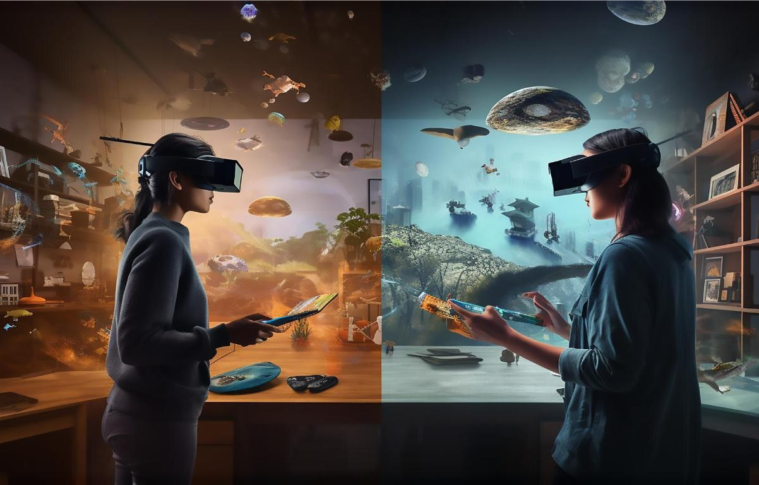Introduction
Augmented Reality (AR) and Virtual Reality (VR) are transformative technologies that are redefining user experiences across industries. While they share common goals of immersion and interaction, AR and VR design differ significantly in their approach, tools, and applications. This case study delves into the principles, challenges, and applications of AR and VR design, demonstrating how they enhance user engagement and solve real-world problems.
Understanding AR and VR
- AR Design
AR overlays digital elements onto the real world using devices like smartphones, tablets, or AR glasses. The design focuses on blending the virtual and physical seamlessly.- Example: IKEA Place App, which allows users to visualize furniture in their homes.
- VR Design
VR creates fully immersive digital environments, cutting users off from the real world. It requires VR headsets like Oculus or HTC Vive.- Example: Google Tilt Brush, an application that lets users paint in 3D space.
Principles of AR Design
- Context Awareness
AR interfaces must adapt to the user’s physical environment. For example, AR navigation apps must consider real-world obstacles and landmarks. - Minimal Intrusion
AR designs should not overwhelm users with excessive digital elements. Instead, they should complement the real-world environment. - Intuitive Interactions
Gestures, voice commands, or touch interactions must feel natural to the user. For instance, pinching to zoom in AR should mirror real-world actions.
Principles of VR Design
- Immersive Environment
Every element in a VR experience, from textures to sound, must contribute to a sense of immersion. - Comfort and Usability
VR designs must avoid causing motion sickness or discomfort. Smooth transitions and controlled movement are critical. - User Control
In a fully digital world, users should always feel in control. Clear instructions and accessible controls are key to reducing frustration.
Case Study: AR in Retail
Scenario:
A luxury watch brand wanted to enhance its e-commerce platform by letting customers “try on” watches virtually.
Solution:
The brand designed an AR app where users could point their smartphone cameras at their wrists to see how different watch models would look and fit.
Key Design Considerations:
- Accurate scaling of the watch size to match wrist dimensions.
- High-resolution 3D models to maintain brand perception.
- Integration of AR features within the existing e-commerce app for ease of use.
Outcome:
- 25% increase in user engagement.
- 15% reduction in return rates as customers made more informed purchase decisions.
Case Study: VR in Training
Scenario:
A manufacturing company sought to train its workforce on operating complex machinery without risking equipment damage or safety.
Solution:
A VR training module was developed, replicating the machinery and processes in a virtual factory environment.
Key Design Considerations:
- Realistic 3D models and physics-based interactions for authenticity.
- A guided training mode and a test mode for evaluating employee performance.
- Scenarios for troubleshooting common mechanical issues.
Outcome:
- 40% improvement in employee skill levels post-training.
- Significant cost savings compared to traditional hands-on training methods.
Challenges in AR and VR Design
- Hardware Limitations:
- AR relies on devices like smartphones or AR glasses, which may lack advanced capabilities.
- VR headsets can be bulky and expensive, limiting accessibility.
- Design Complexity:
- AR and VR require creating 3D assets and ensuring real-time rendering, which demands advanced tools and expertise.
- User Adaptation:
- Many users are new to AR/VR interactions, so intuitive onboarding and tutorials are essential.
Tools for AR and VR Design
- For AR:
- Spark AR Studio: For creating AR effects on social media platforms.
- Google ARCore / Apple ARKit: Frameworks for developing AR apps on Android and iOS.
- For VR:
- Unity and Unreal Engine: Popular platforms for designing immersive VR experiences.
- Tilt Brush and Medium: Tools for creating 3D art and models in VR.
Future Trends
- AR Cloud:
Persistent AR environments that multiple users can interact with simultaneously. - Haptic Feedback:
Integrating touch sensations in VR to enhance immersion. - AI-Powered Experiences:
Combining AR/VR with AI for more personalized and adaptive interactions.
Conclusion
AR and VR design are at the forefront of technological innovation, offering immense potential across industries. By focusing on user-centric principles and overcoming challenges, designers can create experiences that not only captivate but also solve real-world problems. Whether it’s blending digital with reality in AR or crafting entirely new worlds in VR, the future of these technologies is limited only by imagination.



